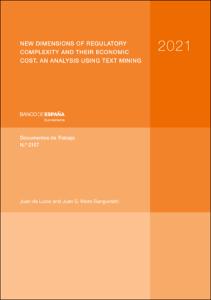New dimensions of regulatory complexity and their economic cost. An analysis using text mining
Autor
Fecha de publicación
9-feb-2021
Descripción física
34 p.
Resumen
Los agentes económicos tienen una mayor dificultad para implementar normativas complejas, produciéndose una disminución de la eficiencia económica. La bibliografía se ha concentrado hasta ahora en el análisis de la complejidad como un fenómeno relacionado con la «cantidad» de normas. Sin embargo, la regulación también puede ser difícil de implementar por razones «cualitativas»: por su ambigüedad lingüística o por tener una estructura relacional (referencias entre documentos legales) compleja. Este artículo innova analizando estas dimensiones y desarrolla nuevos indicadores de legibilidad e interconexión regulatoria. Para ello, construimos una nueva base de datos (RECOS - Complejidad Regulatoria en España) extrayendo información de 8.171 normas (61 millones de palabras) que abarcan la regulación de todas las comunidades autónomas españolas. En nuestro análisis también mostramos la relación de estos nuevos indicadores con variables económicas (productividad) e institucionales (la eficacia judicial). Si bien cada una de estas áreas deberá analizarse en artículos separados, esta investigación revela que las nuevas dimensiones de la complejidad de la regulación (la complejidad lingüística y la relacional) son relevantes y tienen impactos significativos.
Complex or poorly drafted regulations are more difficult for economic agents to implement, eroding economic efficiency. The literature has so far concentrated on the analysis of regulatory complexity as a phenomenon related to the “quantity” of norms. Regulation can also be complex because of “qualitative” reasons such as its linguistic ambiguity or its relational structure (references between legal documents). This article innovates by analyzing these new dimensions of complexity: we develop new indicators for legibility and regulatory interconnectedness. To do so, we constructed a new database (RECOS - Regulatory Complexity in Spain) extracting information from 8,171 norms (61 million words) covering the regulation set of all the Spanish autonomous regions. We analyze the relationship between these new indicators and productivity (as a relevant economic variable) and judicial efficacy (as a relevant institutional-structural variable). While each of these areas should be analyzed in separate articles, this research shows that the new dimensions of regulation complexity matter and also have significant results.
Complex or poorly drafted regulations are more difficult for economic agents to implement, eroding economic efficiency. The literature has so far concentrated on the analysis of regulatory complexity as a phenomenon related to the “quantity” of norms. Regulation can also be complex because of “qualitative” reasons such as its linguistic ambiguity or its relational structure (references between legal documents). This article innovates by analyzing these new dimensions of complexity: we develop new indicators for legibility and regulatory interconnectedness. To do so, we constructed a new database (RECOS - Regulatory Complexity in Spain) extracting information from 8,171 norms (61 million words) covering the regulation set of all the Spanish autonomous regions. We analyze the relationship between these new indicators and productivity (as a relevant economic variable) and judicial efficacy (as a relevant institutional-structural variable). While each of these areas should be analyzed in separate articles, this research shows that the new dimensions of regulation complexity matter and also have significant results.
Publicado en
Documentos de Trabajo / Banco de España, 2107
Materias
Complejidad de la regulación; Productividad; Complejidad lingüística; Complejidad relacional; Corpus jurídico; Regulatory Complexity; Productivity; Linguistic complexity; Relational complexity; Legal corpus; Evolución y desarrollo económicos; Derecho; Economía regional y recursos naturales; Instituciones y economía; España
Aparece en las colecciones:












